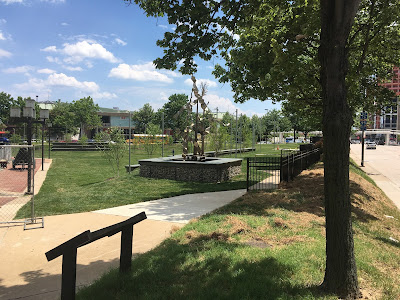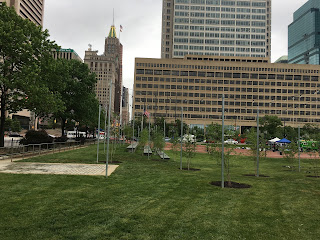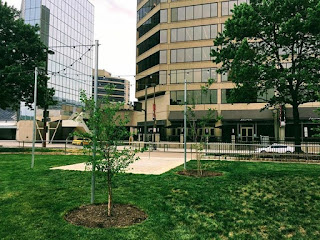What was revealed after the veiled 6' chain-link fence came down is that the full throated tiger Downtown Partnership has fathered a mouse. McKeldin Plaza is now so mundane it wouldn't raise an eyebrow in downtown Arbutus. A bit of grass, a few skinny trees and a 5' perimeter walkway are not able to cover the gaping hole the $4 million demolition of the brutalist fountain left behind in Baltimore's landscape. Strings of light and recovered shiny art round out the decor that would even be able to enhance a Bavarian beer garden.
 |
| The new McKeldin Plaza: grass, trees and berms (Photo Philipsen) |
“This is where Baltimoreans come to celebrate holidays and watch parades. It’s the town square where civil and political opinions are expressed. This new design makes the space better for all of these activities. It’s placemaking on a human scale.” (Kirby Fowler Press release)The only thing the new plaza can claim for itself is that there is no concrete left after fountain and bridges have been removed with much effort and so many dollars that nothing was left for the new design. A plus for those who hate concrete and confuse brutalism (Béton brut) with brutality; to avoid even a speck of concrete, rock caged in chainlink, "gabions" typically used by engineers to stabilize eroded river banks, forms little walls here and there. Not being a brutalist fountain is hardly enough of a program for one of the most prominent parks in Baltimore.
 |
| The fountain that allowed walking through it and was clearly part of the Inner Harbor design |
This is a very disappointing outcome if one cares to remember the promises with which it all started and which were taken back one after the other: As shown in ASG's Harbor 2.0 masterplans, the promise was to connect McKeldin Plaza to Harborplace by closing the four lane traffic connector that slips northbound Light Street to Calvert and eastbound Pratt.
Imagine what Art History would include if all the ‘ugly’ art was destroyed by the haters of their time? Pretty much all of it. Every piece of historically significant art has been hated by a contemporary audience in its day. (Cara Ober in Bmore Art May 2015)The idea of closing those lanes gave traffic engineers hives and was referred to lengthy study conducted by Sabra Wang, a consulting firm where several other hot traffic issues went to die, probably less the consultant's fault than the fact that Baltimore's DOT has been largely rudderless for years.
With the expansion promise gone, the justification for demolition of the fountain was gone as well. But it turned out that the closure of the dogleg was nothing but a pretext for those intent on knocking the fountain down, come hell or high water. It was the money from the owner to the west who looked across the street against the fountain's pump room door spoke.
 |
| The original Ziger Snead/ Mahan Rykiel redesign of McKeldin Plaza |
Now the promise shifted to "world-class park design" on par with Chicago's Centennial Park. In July 2015 a Downtown Partnership representative introduced the design concept to UDARP in this lofty but accurate assessment:
"DPoB believes that McK Plaza is the maybe the most important civic space. And if it isn't it has the potential to be it".But the design of the hand-picked homegrown design team of Ziger-Snead and Mahan Rykiel was met with scathing comments from the local design review panel UDARP which didn't find anything "world class" in the proposal. Panelist Richard Burns likened the proposed water wall to a hotel lobby design ("I have seen this at a Marriott") and determined that nothing about it was specific to Baltimore.
In response DPoB suddenly scuttled the design and there was whispering about a design competition. Another ruse. DPoB saw a chance to knock the fountain down and then do almost nothing. In a special kind of irony, UDARP panelist Rubin gave a hand in the design of the temporary fix that is now on display, either a blatant violation of the rule that panelists can't design what they critique or abuse of a very capable designer. Rubin, an excellent and sharp critic, a Harvard trained landscape architect, couldn't win when confronted with Fowler's budget that never included more money than what was needed for the costly demolition.
 |
| Gabion stsyle walls and bling sculptures (photo: Kevin Lynch) |
Exactly a year ago I wrote this on Community Architect Daily:
The new zoning code prohibits the demolition of buildings before a replacement is designed, approved and funded. It isn't clear why that logic shouldn't apply here, too. What could possibly be worse than a half-baked underfunded provisional open space?
The current fountain has the heft and scale to holds its own in a sea of traffic. The cascading water provides a sound that neutralizes the traffic noise to some extent; the steps, bridges and structures make it a walkable big sculpture and offer many surprise views, The illumination at Light City Baltimore showed how easy it would be to spruce the fountain up, especially at night. No doubt, a better design is possible, except it hasn't see the light of day, yet. McKeldin Fountain in its current form is an important public space and its disposition should not be left to private entities, no matter how laudable many initiatives of DPoB are or have been.Of course, what we have now is precisely that, a half-baked underfunded provisional open space easily outwitted by the new temporary Sandlot park at HarborPoint. As if DPoB wanted to make sure that even more energy travels east on Baltimore's waterfront. In spite of the designs flatness, the surrounding walkway isn't even accessible when it ends in a sudden a dangerous double step.
The new McKeldin Plaza: Bling and shrubs (Photo: Elliott Plack)
Kirby Fowler will tell concerned citizens not to worry, the real design is yet to come. Why should anyone believe this? It is well established that temporary solutions are the most enduring. They better be really good to start with.
Klaus Philipsen, FAIA
 |
| A poorly drained 5' perimeter walk has all the charm of a suburban sidewalk (photo: Klaus Philipsen) |
 |
| What to do with these lawns, another suburban design staple (photo: Klaus Philipsen) |
 |
| a few tiered benches suggest that there would be something to see (photo: Klaus Philipsen) |
 |
| The tiny trees suggest that a long life for this temporary fix is expected (photo: Klaus Philipsen) |
 |
| Nothing here has the scale to hold its own in a setting of massive structures and traffic (photo: Klaus Philipsen) |
 |
| McKeldin Plaza now: A flat island in a sea of traffic and pavement (photo: Klaus Philipsen) |
 |
| The McKeldin fountain hadn't been abandoned as many tried to tell us (photo: Ryan Patterson, Bmore Art) |
 |
| This image shows how much the fountain was a part of the Inner Harbor setting and protected users from the trucks and traffic all around (Photo: Philipsen) |
A sudden reversal on McKeldin Plaza design
The McKeldin Fountain Folly Continues
McKeldin Fountain back to UDARP
McKeldin Fountain catches Council President's Attention
New McKeldin Plaza Design Unveiled
McKeldin Fountain Its Fate is Sealed
Cara Ober in Bmore Art in May 2015: THE DOWNTOWN PARTNERSHIP’S LACKLUSTER PLANS FOR MCKELDIN PLAZA AND FOUNTAIN

So on target. City and architects should be ashamed for this banality.looks like a school backlot
ReplyDelete